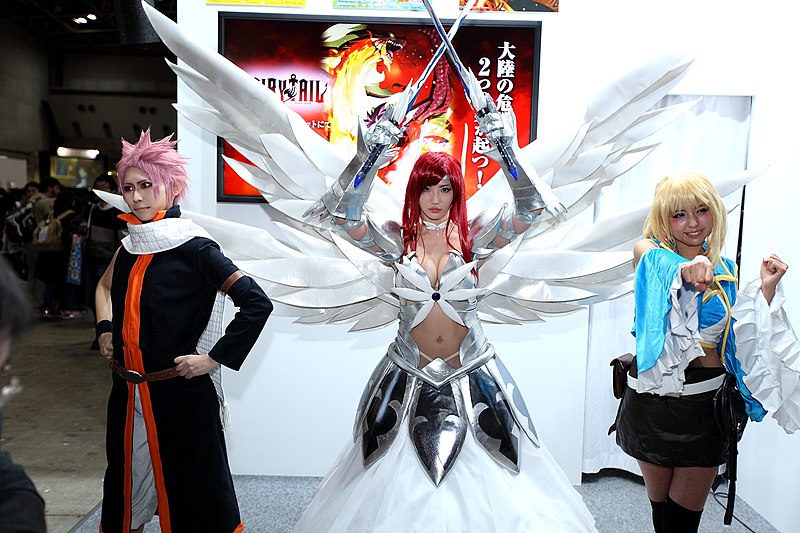
We all love sci-fi and fantasy. It’s why we all go to cons, buy comics, books, and Blu-rays of our favourite story-lines. We like to have T-shirts, miniatures, statues and things that remind us of that which we love surround us. These things make us happy and bring us comfort – but sometimes there’s a problem. Are the things you own legal? Are they officially licensed so that the actual creators and owners are receiving the money, or have you, as so many people have bought something from someone who has been cutting legal corners?
I am an author. In 2010 I composed and published what would be my first novel, Tales of The Airship Neverland. I was a rookie, but I had already written two unpublished works. The first thing I did was to register them with the US Copyright office; as I said, they were unpublished. However, with Airship Neverland since it was a re-imagination of Peter Pan, I made sure the book was legal to do.
This required some investigation of whether or not J.M. Barrie’s estate still holds the copyright. Peter Pan or The Boy Who Wouldn’t Grow Up was a play written 1904 and was first introduced in The White Bird in 1902. In US law, the default length of a registered copyright is between 50-70 years. Copyrights can be renewed, which, as an example, is why DC comics still have exclusive protections on Batman and Superman.

Not all nations’ copyright protections have the same length. To wit England; under UK laws the play Peter Pan is still in copyright until 2023. Since the US doesn’t recognize those standards, Peter Pan is considered in Public Domain. I researched this carefully as I didn’t want my head handed to me in a court of law.
What we need to understand is that authors and artists are frequently exploited, or think they are by companies who seek to profit off their work. One of these matters that frequently sparks debate is the case of the creators of Superman.
If one was to look at the case of Joe Siegel and Jerry Schuster – the creators of Superman who in 1933 created the character and then in 1938 sold the character to Detective Comics for the sum total of $130. Later, as the character became the mythic character, Siegal and Schuster tried to sue to retain rights and monies from his success. This would be an ongoing battle until they died. Their family still pursues this matter. However, since they sold the character and DC bought the rights, legally speaking they will continue to rightly or wrongly, lose.

Copyrights protect both the creator and the owners of copyrights. These copyrights are designed to protect what is known as IP or Intellectual Property.
While I did not create Peter Pan or accompanying characters, my re-imagined characters and stories are now my Intellectual Properties. The difference is that I have taken characters and altered them and created something entirely new. But of course, I still credit the original author and creator as a matter of acknowledging that his works inspired me.
Now there is a difference in between re-imagining something and outright stealing. Anything in the Public Domain – meaning that it was never copyrighted, or the copyright has lapsed and never renewed is open game.
For example, the film The Last Man on Earth – based on a screenplay by the author of the original novel, Richard Matheson , is now in public domain, but his original written book is not. Mister Matheson died in 2013. This case, it should be said, is a very unusual situation. Others are not so complex.
Some things, however, should just be obvious.

Artists who create pieces of work that becomes popular, or goes viral, need to and should have, copyrights on their artwork. The main reason is that it is incredibly easy with today’s technology to take an online image and copy and save it. This is frequently done, and even my artwork and designs have been pirated – blatantly. Many people have said artist whose works have been illegally used ought to be flattered, and that it’s ‘good exposure.’
No, it’s not. It is outright theft.
Within one week of being published, my novel was being sold by a company based out of China. They took the digital version of my book and simply listed it for sale without changing the name, title or even the cover art. I will never see any money from that company, and because that nation ignores copyrights, they likewise pirate artwork, music, film, miniatures and anything else they want. Copyright violations are the source of frequent conversations when trade agreements are discussed with China. The cost of those thefts are in the billions to US copyright and patent holders.

But IP theft is not limited to China, for every time you walk down Artist’s Alley at any Comicon, you will see people whose artwork is that of film, comic, and TV characters. These artists who get angry at their work being pirated are often creating artwork of others’ IP. In point of fact, if they do not have a license agreement from the copyright holder, they are committing copyright violations.
Quoting from the University of Purdue website, “The legal penalties for copyright infringement are: Infringer pays the actual dollar amount of damages and profits. The law provides a range from $200 to $150,000 for each work infringed. Infringer pays for all attorney’s fees and court costs.” That’s per infringement. Imagine how many ‘Spider-Man’ illustrations are sold over a 4-day con event.
An argument has been made that those companies don’t care. Maybe, or maybe they permit it because the cost of litigating against 10,000 artists wouldn’t bring in significant recoverable assets. There is a danger in that philosophy, because it’s not true. There have been severe fan missteps, however. Before I address that, let us discuss fandom.

Fandom is a relatively new human creation, coming on the heels of mass media. Ever since the advent of comics and film people have dressed up as their hero’s; going from Roy Rogers and the Lone Ranger to current cosplay of such eclectic characters as Guy Fleegman from Galaxy Quest. And Deadpool, tons and tons of Deadpools.

By and large Entertainment companies are okay with this as its essentially free advertising. The joy and love that fans have for a brand or entertainment brands is a multi-billion dollar marketplace. People may see a beautiful cosplay and ask what it’s from and then fall in love with a new story or film. If it wasn’t for someone calling out for never having seen Firefly, I would not now own the DVD series and have a Brownshirt patch on my coat.
Fandom can, however, bite the hand that feeds it.

A fan film is a cinematic homemade story told about such things Star Wars, Batman, Robin (See one of my favorites, the fantastic Grayson fan film here.)

Many of these films are so beautifully told that they become classics, such as from the Star Wars universe, Troops, Pink Five, Star Wars: Revelation, and for my top award, the anime: Star Wars: TIE Fighter. These films showcase not only love but extreme talent from actors, cinematographers, and digital illustrators. George Lucas even has a favourite; George Lucas in Love.
Star Trek has generated the same level of loyalty on a level that Star Wars fans bicker whose fandom is better. This loyalty as featured in the film Fanboys, wherein one scene Star Wars and Star Trek fans have a go at each other. Now Star Trek, because of its episodic roots has created home-brewed series with actors taking on the classic roles of Kirk, Spock, and the rest. The first one I was exposed to was James Cawley’s amazing Star Trek: New Voyages. One episode of this show even had George Takei in it. I was hooked. This series would not be only one to follow the episodic formula, home-brew shows would continue with the like of Star Trek: Hidden Frontier, Starship Exeter, and James Cawley’s other series, Star Trek: Phase II. One of the hallmark series was Star Trek of Gods and Men – featuring much of the original Trek Actors. However, perhaps the best film, and maybe the most infamous fan production was Star Trek: Axanar.
To my mind, I will still rate Prelude to Axanar as having the most exceptional production value, solid premise and acting of any Trek fan film I have ever seen.

© Axanar Productions, 2014
The success and popularity of Axanar was astounding. The plot of the film is the story of Garth of Izar, (Introduced in TOS episode Whom Gods Destroy) recalling q great battle from the ‘the Four Years War’ with the Klingon Empire. In short, Axanar was, and is, a masterpiece. Regardless of any other feelings I have about it’s production, I stand by this opinion to this day.
This proof of concept production was so heralded that the director (and actor portraying Garth of Izar) Alec Peters sought to raise the budget to complete a full film. He would raise two million dollars, twenty of that my own money. So, since I contributed financially, I have no compunctions about critiquing it’s failings as I see them.
The ensuing legal battle is a long and sordid tale between Peters and Paramount claiming, Fair usage and counterclaims, justly I believe, of theft or misuse of intellectual property. The call of Fair Use struck me, and others, as a bit thin as the story motiff was based upon Star Trek’s established universe, costuming, and iconography. To make it more obvious, the film had actors recreating their roles from Star Trek series, by name. The court would agree. From IPWatchdog.com 2017/1/18
“Critically for purposes of trial, the Court evaluated the four factors that courts use to determine whether fair use may exist (17 U.S.C. § 107) and held that Defendants are not entitled to a fair use defense. Generally speaking, the fair use (affirmative) defense allows a defendant to establish that although its use of a copyrighted work might technically be infringing, the infringement is excused under the circumstances because the defendant’s work is being used for a “transformative” purpose (e.g., research, scholarship, criticism, journalism). The Court didn’t buy it. According to the Court, all four factors weigh in Plaintiffs’ favor, from the purpose and character of the infringing use to the effect of the use upon the potential market. The Court also found that the Axanar Works’ mockumentary style of production does not constitute a legally protectable form of parody because Defendants’ works do not adequately criticize Plaintiffs’ copyrighted works. In wrapping up its opinion, the Court further held that it would be inappropriate to find on summary judgment that Mr. Peters’ conduct at issue was willful, but sufficient evidence exists to allow Plaintiffs’ claims of contributory and vicarious infringement against Mr. Peters to proceed to trial.“
Now, Paramount/CBS/Desilu films own Star Trek. Whatever the argument may be for whichever side you’re on, the end result was the lawsuit resulted in an injunction that ended any further production.
I, for one, was rather saddened that we would not get to see the full film.

I genuinely hoped that Alec Peters would get hired by Paramount/CBS and be a shaper of future Trek productions. In my opinion his image of Star Trek far exceeded that of Star Trek: Discovery. The man truly knows his Trek and is clearly a visionary artist. His failing, IMHO, was his hubris and selfishness.
Nevertheless, a legal settlement reached by CBS, Paramount and Axanar Productions allowed the creation of two short films, totaling 30 minutes, instead of the feature-length movie planned by Peters.
What came after that had me, and a host of other fan film producers, actors, crafters, and talent, royally pissed off.

The legal settlement against Peters and Axanar was devastating, and it’s reach went far beyond Prelude to Axanar. The ruling still affects thousands of other fan creators. According to StarTrek.com, fan productions must now be less than 15 minutes for a single self-contained story or no more than 2 segments, episodes or parts, not to exceed 30 minutes total, with no additional seasons, episodes, parts, sequels or remakes.

In short the Axanar fiasco, in my opinion, effectively killed Star Trek fan films. This was, and is, because of the careless and arrogant overreach of copyright and intellectual property rules. Up until then Star Trek fan films were left alone, enjoyed and frequently produced and featured such people as Walter Koenig, Nichelle Nichols, and even fans such as Mythbusters Grant Imahara.
Alec, I think you’re amazing but as an attorney you should have known better. Trek wasn’t and isn’t just about you.
People, copyrights matter.
Copyright infringement and open theft is rampant, and people need to understand that companies, no matter how wealthy have every right to drop the banhammer or serve you with court papers if you steal their property. Right now the most recent example has been the illegal merchandising – meaning people are making money off of something that isn’t theirs – of The Madolorian’s “Child”, or as you may know him/her/it, Baby Yoda.

People are selling merchandise of him on Etsy, patterns for printing 3D objects of him, and of course, T-shirts. Fortunately Disney and Kathleen Kennedy aren’t having any of that, and have slammed down hard.

They’ve slammed down just as hard as Universal and JK Rowling does on Harry Potter festivals. Why, when they are so rich? Because they made and / or own the bloody things.


Rowling was a very creative and deserving woman when she drafted the first notes to what is now a beloved and enduring mythos, Harry Potter. Trust me; she got my and my wife’s money when we went to the Wizarding World in Florida. I know Disney has a lot of my friends’ money going to Galaxy’s Edge.

If we want more Star Wars, Star Trek, Harry Potter or what have you, somebody still needs to pay for it. Filmmaking is damned expensive and provides jobs for, collectively, millions of people. Let us look at a few companies we love; Studio Ghibli, Rooster Teeth, Universal, Paramount, NBC, ABC, CBS, HBO, SYFY… and there are so many more.
These people have bills, spouses, lovers, children, medical bills, rent, and mortgages. Every time you pirate a film, or TV series, every time you buy a bootleg T-shirt, you are picking dollar bills from someone else’s wallet.

And frankly, it doesn’t matter if they are worth $130,000,000 like Disney, or less than $70,000 like me. I aspire one day to sign deals with major publishers and filmmakers so I can see my Airship Neverland soar across the sky. I would love to crowd fund a budget of $2,000,000 and make a film. I would like that, but right now I don’t make much money from my work and need every penny to help pay my bills.
And you know what; there are ten thousand other artists and writers that need that money too. We love making it; it just so happens that we deserved to be paid for our labours.
Come on, toss a coin to your Witcher, mates.
-30-
John R. White is a USAF veteran, and has served as Art Director for the Honor Flight Network, and Honor Flight Northwest Ohio. He is most well known as the Author of ‘The Tales of the Airship Neverland’ steampunk series, and the author and designer of the ‘Airship Neverland’ Roleplaying game.










